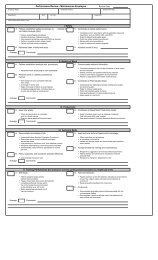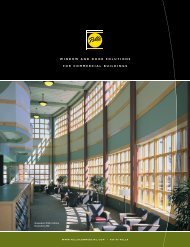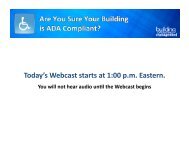Building Operating Management September 2011 - FacilitiesNet
Building Operating Management September 2011 - FacilitiesNet
Building Operating Management September 2011 - FacilitiesNet
Create successful ePaper yourself
Turn your PDF publications into a flip-book with our unique Google optimized e-Paper software.
uildingoperatingmanagement<br />
SEPTEMBER <strong>2011</strong><br />
103<br />
PREVIEW<br />
FACILITY DECISIONS<br />
Tax Benefits for Efficiency Projects<br />
From HVAC upgrades to LEED projects, federal tax<br />
deductions may help justify energy investments<br />
The summer of <strong>2011</strong> began much like any other,<br />
with pockets of scorching temperatures affecting<br />
states throughout the Midwest and Southwest and<br />
heavy rains drenching others along the East Coast.<br />
Across the country, facility managers continued<br />
to pursue strategies that offered the most energyefficient<br />
operation of HVAC systems, lighting, and<br />
building controls. Some facility organizations<br />
considered equipment upgrades,<br />
while others planned a<br />
retooling and recommissioning<br />
of existing systems. As usual,<br />
budget played a big factor<br />
in determining next steps.<br />
Then two extraordinary things<br />
happened: the U.S. debt ceiling rose,<br />
and the stock market plunged.<br />
Facing an incredibly unpredictable<br />
environment, many facility<br />
operating budgets were suddenly<br />
in peril. And those energy<br />
efficiency initiatives? They were<br />
in danger, too.<br />
They don’t have to be, according<br />
to Charles Goulding, president and<br />
founder of Energy Tax Savers Inc., which<br />
specializes in advising building owners, architects, engineers<br />
and designers on tax benefits related to energy saving building<br />
investments.<br />
Last year’s updates to the Energy Policy Act (EPAct) have<br />
ushered in “a whole new category of projects qualifying for<br />
HVAC tax deductions,” says Goulding, who will be presenting<br />
“Using EPAct to Make Energy Projects Possible” at next<br />
Charles Goulding<br />
will discuss the impact<br />
of changes to the Energy<br />
Policy Act (EPAct) at<br />
next month’s Facility<br />
Decisions conference<br />
in Las Vegas.<br />
Facility Decisions is free<br />
to attend and will be held at<br />
the Mirage Event Center in<br />
Las Vegas. Hotel rooms are<br />
also available at the Mirage.<br />
Call 800-499-6311 to<br />
reserve now.<br />
FacilityDecisions.com<br />
Facility Decisions Pre-Conference<br />
Workshops Offer More Ways to Cut Costs<br />
Two pre-conference workshops are available to Facility Decisions attendees on<br />
Monday, Oct. 11 from 1 p.m. – 5 p.m. The cost is $149 in advance, $249 on-site.<br />
Learn more at www.nfmt.com/education<br />
Workshop 1: Best Practices for<br />
Energy <strong>Management</strong><br />
Presented by Richard G. Lubinski, CEM,<br />
CDSM, CSDP, CEMSC, BEP, President,<br />
Think Energy <strong>Management</strong> LLC, and<br />
Bob Holesko, Vice President, Facilities,<br />
HEI Hotel and Resorts<br />
Workshop 2: Measure What You<br />
Manage: How to Communicate<br />
Performance vs. Goals<br />
Presented by Michael B. Cowley,<br />
CPMM, President, CE Maintenance<br />
Solutions<br />
EVENT HOURS<br />
Monday, Oct. 10<br />
Pre-conference Workshops<br />
(fee applies): 1 p.m. – 5 p.m.<br />
Tuesday, Oct. 11<br />
Conference Sessions:<br />
8 a.m. – noon<br />
Exhibit Hall: noon – 4 p.m.<br />
Opening Night Party:<br />
3 p.m. – 4 p.m.<br />
Solutions Exchange:<br />
4 p.m. – 5 p.m.<br />
Wednesday, Oct. 12<br />
Conference Sessions:<br />
8 a.m. – 11 a.m. & 2 p.m. – 4 p.m.<br />
Exhibit Hall: 11 a.m. – 2 p.m.<br />
month’s Facility Decisions Conference & Expo in Las Vegas.<br />
“EPAct benefits are applicable to investments made to<br />
reduce energy use,” says Goulding, adding that the current<br />
push toward LEED certification is a natural fit for EPAct tax<br />
deductions as well. “LEED buildings and EPAct integrate<br />
almost perfectly. Any time you have a LEED building, you<br />
should be thinking that you’re platformed for tax savings.”<br />
Goulding points to 11 categories of HVAC equipment<br />
that now fall under EPAct’s Section 179(D), noting that<br />
many of them are becoming more<br />
widely adopted throughout the facilities<br />
management marketplace and<br />
include thermal storage, demand<br />
control ventilation, chilled beam ceilings,<br />
magnetic bearing chillers and<br />
VAV devices in buildings of less than<br />
75,000 square feet.<br />
For facility managers who develop<br />
expertise in applying these deductions,<br />
an unbeatable opportunity to recoup<br />
upgrade investments and save energy<br />
dollars for the long haul awaits. And<br />
in a world where financial stability is a<br />
long way off, these tax savings offer a<br />
way forward for vital energy- and costsaving<br />
projects. ■





